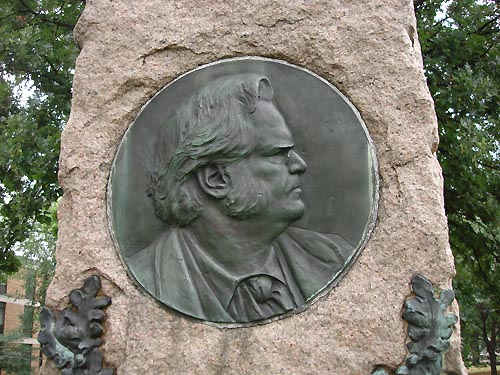Bjørnstjerne Bjørnson Bautastein
County: Cass, North Dakota

Location: central campus NDSU, between Old Main and Putnam Hall
Coordinates: N46o53.473' W96o48.019'
Few students or faculty members at NDSU are aware of whose image is represented in the 13-foot statue next to Putnam Hall. Hewn from red granite, the monument pays tribute to the Norwegian poet, patriot, playwright, and novelist Bjørnstjerne Martinius Bjørnson. The bronze medallion which bears Bjønson's image in profile on the north side of the monument was cast by Sigvald Asbjornsen.
Bjørnson featured prominently in Norway's cultural and political history as a brilliant writer and tireless advocate of national independence and constitutional democracy. A man of many talents, Bjørnson composed the Norwegian national anthem and was revered in his time (1832-1910) as a hero of the nation. His friend, composer Edvard Grieg, described Bjørnson in 1903 as "our wakeful conscience. Because it is through you that we feel Norway's pulse."
After attending the University of Oslo, Bjørnson quickly rose to prominence in the literary world upon publication of the novel Synnøve Solbakken (Sunny Hill) in 1857. Bjørnson's early work was shaped by his concern for the plight of peasant farmers on rugged terrain and is steeped in the rich tradition of Norse saga. He went on to publish numerous works of historical fiction and lyric poetry, receiving the Nobel Prize in Literature in 1903 at the age of 71.
Initially skeptical about the United States, Bjørnson became enamored of the vitality of American democracy during an 8-month visit to the US in 1880. Bjørnson was thus a natural symbol for Norwegian Americans seeking to preserve their cultural heritage and national memory. The driving force behind the commemorative statue at North Dakota Agricultural College was Dr. Herman O. Fjelde, a Norwegian immigrant and physician who helped fund and facilitate its erection. Fjelde selected NDAC as the site due to its status as a land-grant college, a reflection of Bjørnson's lifelong commitment to the welfare of farmers.
Built with granite from Bjørnson's estate in Norway, the statue is a Bautastein, Norwegian for a "roughly cut stone monument" traditionally used to honor Viking leaders. It was unveiled May 17, 1904, on Norwegian Constitution Day at a ceremony in which the participants joined in singing the Norwegian national anthem. Sadly, the obscurity of the statue's identity, and the dust accumulating on Bjørnson's books in the campus library, testify to the monument's inability to preserve a common historical memory of a most uncommon man.--Research by John Andrews, HIST 489, NDSU, Spring 2007
Recommended Reading
Semmmingsen, Ingrid. Norway to America: A History of the Migration. Minneapolis: University of Minnesota Press, 1978.
Falnes, Oscar J. Norway and the Nobel Peace Prize. New York: Columbia University Press, 1938.
Hunter, William C. Beacon Across the Prairie: North Dakota's Land-Grant College. Minneapolis: Lund Press, 1961.
Bjørnson, Bjørnstjerne. Arne. Trans. by Rasmus B. Anderson. Boston: Houghton, Mifflin, 1881.
Biography of Bjørnson by William Morton Payne / Nobel Prize for Literature 1903
| Photo Gallery |
 |
 |
 |
 |
 |
 |
Video
19 May 2007 |
|---|
Want to talk about this monument, or other heritage sites on the northern plains? Join the discussion on Facebook. Check out the center's Facebook group, Heritage Trails.
 Remembrance in Stone / Center for Heritage Renewal
Remembrance in Stone / Center for Heritage Renewal
|